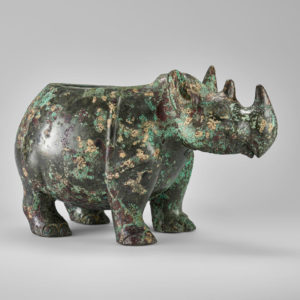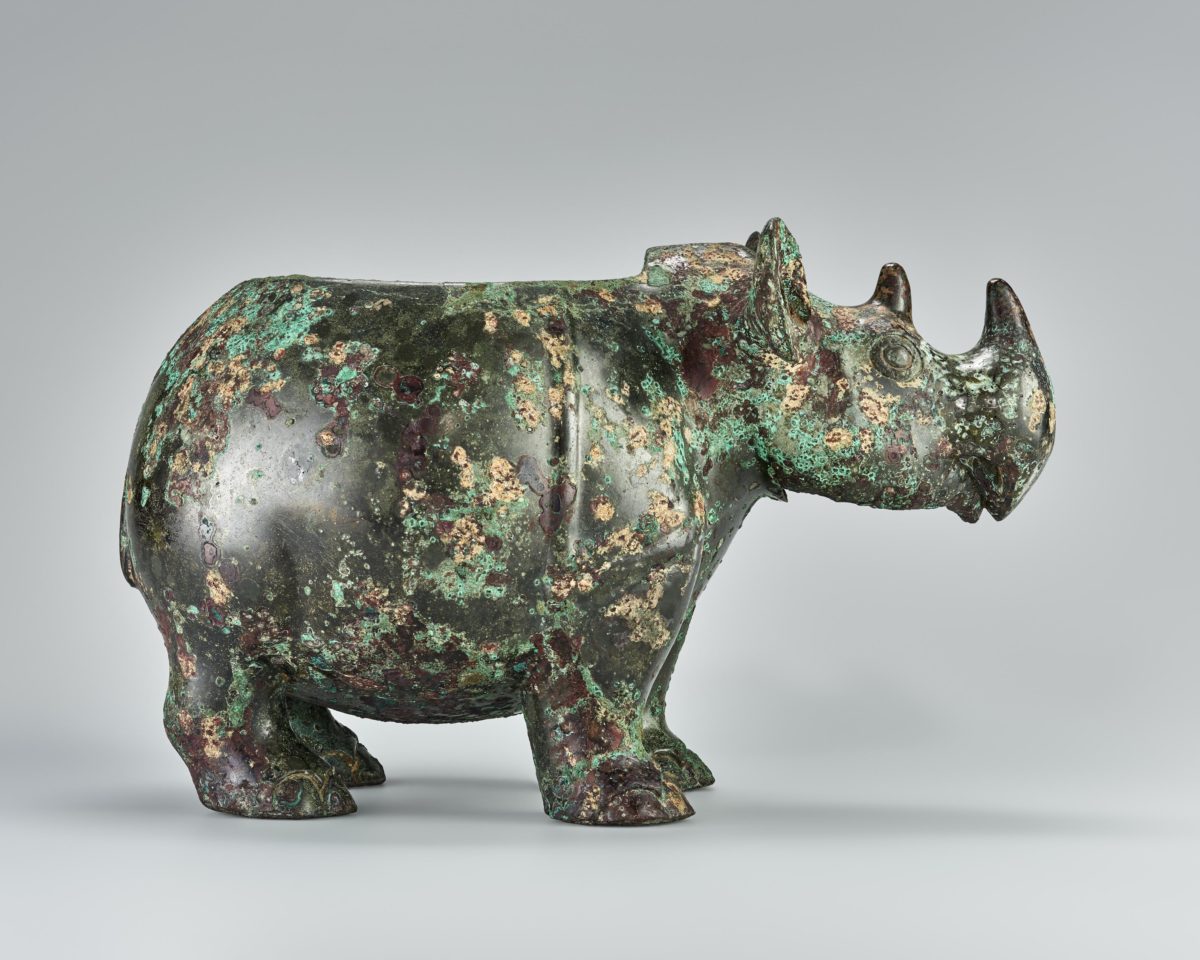One of the only Bronze Age Chinese vessels made in the shape of an animal, and the museum’s mascot.

Ritual vessel in the shape of a rhinoceros
Probably 1100–1050 BCE
China; unearthed in Shouzhang, Shandong province
Shang dynasty (approx. 1600–1050 BCE)
Bronze
The Avery Brundage Collection, B60B1+
The most famous object in the Asian Art Museum’s collection and among the most celebrated ancient Chinese bronzes in the world, this is the only bronze work in the form of a rhinoceros known to have been made during the Shang dynasty (approx. 1600–1050 BCE). A rare inscription records a military campaign and the date this vessel was made. The astounding naturalism of the work — the folds of the rhino’s thick skin evoke a real rhino hide; the ears stand up and extend outward, indicating a state of alertness; and the drooping belly gives a sense of the weight of the animal — suggests that the artist had seen a real rhinoceros, a species now extinct in China.

This rhinoceros-shaped vessel is extraordinary for two reasons: its shape and the text inscribed inside it. Animal shapes are rare among Bronze Age Chinese vessels, but this one is unique for portraying a lifelike rhinoceros, a species now extinct in China.
Modeled from Life
This lively and powerful-looking rhino differs from most animal-shaped ritual bronzes of ancient China, which tend to be covered with surface decorations. The museum’s rhino looks much like the real animal with puckered hide and folds of flesh.
The vessel was created using the piece-mold casting technique. It was cast in one piece, with two cores: one for the cavity in the body, and the other for the open space beneath the muzzle.
How Were Molds Made?
After a clay model of the rhino vessel was made, soft clay slabs were pressed against the model to take an impression. These slabs became the outside sections of the mold and were assembled around the cores of the body and the head. Spacers held the outer mold away from the cores to allow molten bronze to flow in between, creating the thickness of the walls.
What Do X-rays Reveal About the Vessel?
Bronze spacers, called chaplets, were strategically placed to maintain a gap between the mold and the core, so molten bronze could flow between the two. The areas where these spacers were in contact with the core and the outer sections of the mold are often visible in the finished piece or through X-ray imaging. Their existence indicates that this vessel was cast using the piece-mold technique.
This rhinoceros-shaped bronze exemplifies a type of luxury object used by aristocrats during the Shang dynasty. This vessel, originally with a lid (now missing), likely functioned as a container for alcohol. The liquid was offered as a sacrifice to the gods or ancestors at rituals that incorporated ancient Chinese religious beliefs.
This bronze’s historical importance also lies in the inscription cast on the bottom of the inside of the vessel. Not only is this text an essential guide to the standardization of early written Chinese, it is also an invaluable record of a Shang king’s military and ritual acts from his time.
The inscription inside the vessel reads:
On the day dingsi [the 54th day of the ancient Chinese sixty-day cycle], the King inspected the Kui temple,
The King bestowed upon Xiaochen [Lesser Minister] Yu cowry shells from Kui,
It was the time when the King returned from the military campaign against the Renfang,
It was the King’s fifteenth sacrificial day in the rong-ritual cycle.
This 27–character inscription provides firsthand information about society in the late Shang, which was centered in what is now the city of Anyang in central China. Cast at the same time as the vessel, the inscription is rare among Shang dynasty descriptions because of its length. It tells us that an unnamed king of the Shang dynasty was drawn into a military campaign against a region called Renfang. According to one of the interpretations, during his inspection of Kui temple, the king was pleased with the good service he received from Lesser Minister Yu. As a result, the king awarded Yu with cowry shells, a type of ancient currency.
The inscription employs the main form of Shang calligraphy, known as bronze script. In this inscription, the style of the script is fully developed, expressing in written form a formal structure based on philosophical principles of the time.
The discovery of this rhinoceros-shaped bronze was an important event in the history of modern Chinese archaeology. In 1843, the vessel was found in a cache of seven bronzes buried at Shouzhang in Shandong province, homeland of the great philosopher Confucius (551–479 BCE). The set of seven was immediately published by the local government in the county annals, but was not illustrated. The rhino remained in the possession of Confucius’s descendants for several generations.
These seven works were finally identified by historians in the 1980s, 140 years after their discovery. While two are still unaccounted for, the other five are scattered among collections in the United States, China, and Japan. Historians continue to debate certain questions surrounding the rhino, such as which of the kings among the late Shang rulers made the vessel, the exact identity of its recipient Xiaochen (Lesser Minister) Yu, and what specific role he played to deserve the rhino. Ongoing archaeological excavations may unravel some of these mysteries.
Only two bronze rhinoceroses are known to have survived from ancient China, this one from the Asian Art Museum’s collection and a later Wester Han period rhino now in the collection of the National Museum of China in Beijing.
The fantasy of the sacred rhinoceros continued in China for more than two thousand years. Artisans continued to make rhino-formed ritual vessels. Many were crafted with features like those of a deer or horse, but were still recorded in historical documents as a “rhinoceros vessel” or simply a mythical creature.
The two-horned Sumatran rhinoceros roamed parts of the Asian mainland 3,000 years ago. Oracle bones used in rituals during the Shang dynasty mentioned rhinoceros hunts, hinting at the animal’s importance. Today, the Sumatran rhino is the most endangered of all rhinoceros species.
What Is the Status of This Species Today?
Ancient oracle bones suggest that capturing rhinoceroses and sacrificing them during rituals was a significant state event during the Bronze Age. Today, the Sumatran rhino is the most endangered of all rhinoceros species, due to habitat loss and poachers harvesting their horns. Experts estimate that the Sumatran rhinos are down to around 80 animals in the wild, all found between the islands of Sumatra and Borneo in Indonesia. Their best hope for survival is through continued protection under armed guard, captive breeding efforts, and the consolidation of small, fragmented populations into larger ones.
Why Was the Horn Sought After?
Rhinoceros horn was prized in China as a material for luxury objects and was thought by some lo be able to detect poison and increase male virility. The horn was ground for medicine and carved into elaborate poison-detecting drinking vessels for wealthy patrons.
Climate change along with overhunting and the destruction of habitat have caused the rhinoceros to become extinct in China and mainland Asia, with the only viable population living in Indonesia.